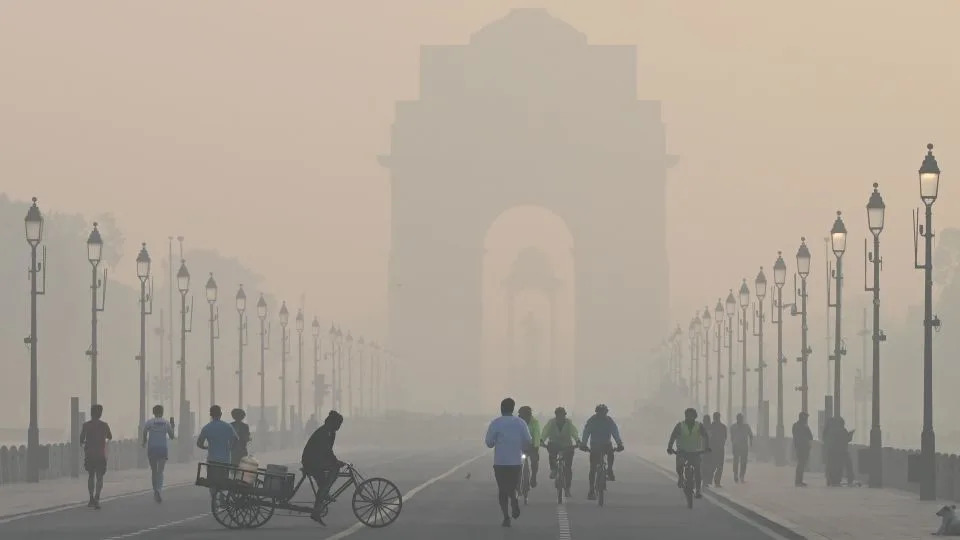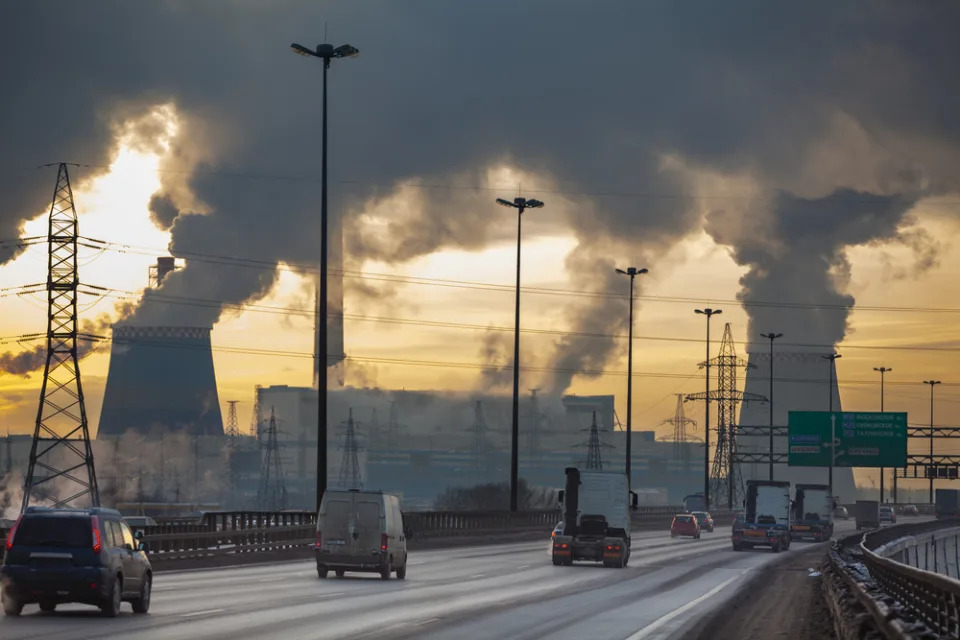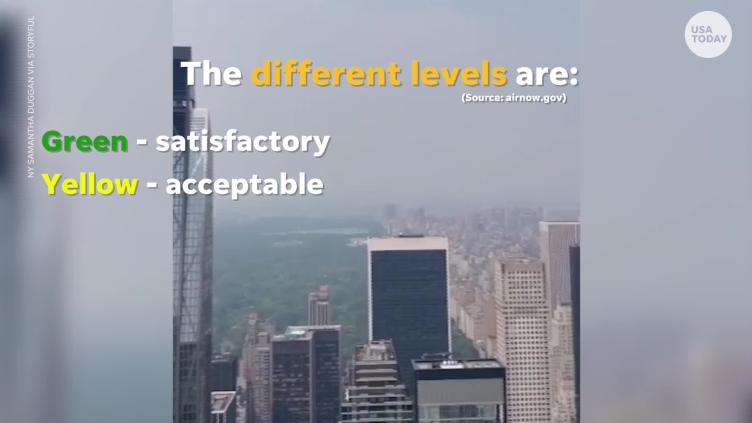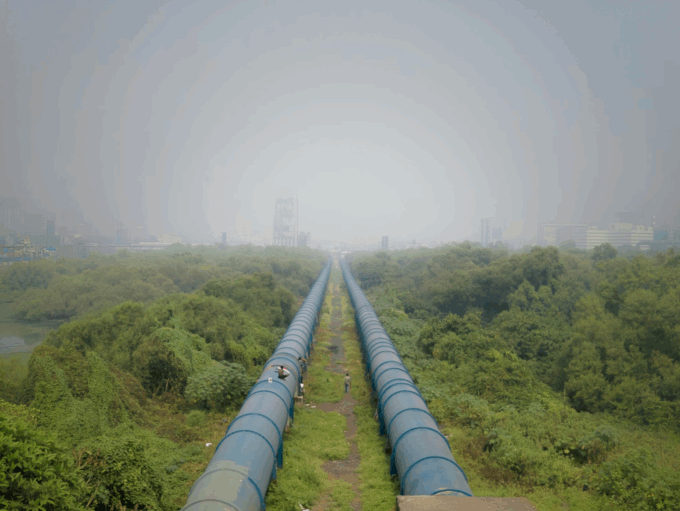By AFP
November 23, 2024

New Delhi is choked every year in noxious smog that authorities appear powerless to bring under control - Copyright AFP Money SHARMA
Arunabh SAIKIA
Noxious smog smothering the plains of north India is not only choking the lungs of residents and killing millions, but also slowing the country’s economic growth.
India’s capital New Delhi frequently ranks among the world’s most polluted cities. Each winter, vehicle and factory emissions couple with farm fires from surrounding states to blanket the city in a dystopian haze.
Acrid smog this month contains more than 50 times the World Health Organization recommended limit of fine particulate matter — dangerous cancer-causing microparticles known as PM2.5 pollutants, that enter the bloodstream through the lungs.
Experts say India’s worsening air pollution is having a ruinous impact on its economy — with one study estimating losses to the tune of $95 billion annually, or roughly three percent of the country’s GDP.
The true extent of the economic price India is paying could be even greater.
“The externality costs are huge and you can’t assign a value to it,” said Vibhuti Garg, of the Institute for Energy Economics and Financial Analysis.
Bhargav Krishna of the Delhi-based research collective Sustainable Futures Collaborative said “costs add up in every phase”.
“From missing a day at work to developing chronic illness, the health costs associated with that, to premature death and the impact that has on the family of the person,” Krishna told AFP.
– ‘Health and wealth hazard’-
Still, several studies have tried to quantify the damage.
One by the global consultancy firm Dalberg concluded that in 2019, air pollution cost Indian businesses $95 billion due to “reduced productivity, work absences and premature death”.
The amount is nearly three percent of India’s budget, and roughly twice its annual public health expenditure.
“India lost 3.8 billion working days in 2019, costing $44 billion to air pollution caused by deaths,” according to the study which calculated that toxic air “contributes to 18 percent of all deaths in India”.
Pollution has also had a debilitating impact on the consumer economy because of direct health-related eventualities, the study said, reducing footfall and causing annual losses of $22 billion.
The numbers are even more staggering for Delhi, the epicentre of the crisis, with the capital province losing as much as six percent of its GDP annually to air pollution.
Restaurateur Sandeep Anand Goyle called the smog a “health and wealth hazard”.
“People who are health conscious avoid stepping out so we suffer,” said Goyle, who heads the Delhi chapter of the National Restaurant Association of India.
Tourism has also been impacted, as the smog season coincides with the period when foreigners traditionally visit northern India — too hot for many during the blisteringly hot summers.
“The smog is giving a bad name to India’s image,” said Rajiv Mehra of the Indian Association of Tour Operators.
Delhi faces an average 275 days of unhealthy air a year, according to monitors.
– ‘Premature deaths’ –
Piecemeal initiatives by the government — — that critics call half-hearted — have failed to adequately address the problem.
Academic research indicates that its detrimental impact on the Indian economy is adding up.
A 2023 World Bank paper said that air pollution’s “micro-level” impacts on the economy translate to “macro-level effects that can be observed in year-to-year changes in GDP”.
The paper estimates that India’s GDP would have been 4.5 percent higher at the end of 2023, had the country managed to curb pollution by half in the previous 25 years.
Another study published in the Lancet health journal on the direct health impacts of air pollution in 2019 estimated an annual GDP deceleration of 1.36 percent due to “lost output from premature deaths and morbidity”.
Desperate emergency curbs — such as shuttering schools to reduce traffic emissions as well as banning construction — come with their own economic costs.
“Stopping work for weeks on end every winter makes our schedules go awry, and we end up overshooting budgets,” said Sanjeev Bansal, the chairman of the Delhi unit of the Builders Association of India.
Pollution’s impact on the Indian economy is likely to get worse if action is not taken.
With India’s median age expected to rise to 32 by 2030, the Dalberg study predicts that “susceptibility to air pollution will increase, as will the impact on mortality”.
The world’s worst air pollution is getting worse, but there are concrete ways to fix it.
by Umair Irfan

Commuters step out in a foggy winter morning amid rising air pollution, on November 19, 2024 on the outskirts of Delhi in India.
India and Pakistan are losing ground to a common deadly enemy. Vast clouds of dense, toxic smog have once again shrouded metropolises in South Asia. Air pollution regularly spikes in November in the subcontinent, but this year’s dirty air has still been breathtaking in its scale and severity. The gray, smoky pollution is even visible to satellites, and it’s fueling a public health crisis.
Last week, officials in the Punjab province in Pakistan imposed lockdowns on the cities of Multan, population 2.1 million, and Lahore, population 13.7 million, after reaching record-high pollution levels. “Smog is currently a national disaster,” senior Punjab provincial minister Marriyum Aurangzeb said during a press conference last week. Schools shut down, restaurants closed, construction halted, highways sat empty, and medical staff were recalled to hospitals and clinics.
Across the border in India, the 33 million residents of Delhi this week are breathing air pollution that’s 50 times higher than the safe limit outlined by the World Health Organization (WHO). The choking haze caused 15 aircraft to divert to nearby airports and caused hundreds of delays. Students and workers were told to stay home.
Despite all the disruption, air pollution continues to spike year after year after year.
Why? The dirty air arises from a confluence of human and natural factors. Construction, cooking fires, brick kilns, vehicles, and burning leftovers from crop harvests are all feeding into the toxic clouds. The Himalaya and Hindu Kush mountains to the north of lower-lying areas like Lahore and Delhi hold the smog in place. In the winter, the region experiences thermal inversions, where a layer of warm air pushes down on cool winter air, holding the pollution closer to the ground.
As populations grow in South Asia, so will the need for food, energy, housing, and transportation. Without a course correction, that will mean even more pollution. Yet history shows that air pollution is a solvable problem. Cities like Los Angeles and Beijing that were once notorious for dirty air have managed to clean it up. The process took years, drawing on economic development and new technologies. But it also required good governance and incentives to cut pollution, something local officials in India and Pakistan have already demonstrated can clear the air. The task now is to scale it up to higher levels of government.
We’re still not getting the full picture of the dangers of air pollution
There’s no shortage of science showing how terrible air pollution is for you. It aggravates asthma, worsens heart disease, triggers inflammation, and increases infection risk. It hampers brain development in children and can contribute to dementia in adults.
On average, air pollution has reduced life expectancies around the world by 2.3 years, more than tobacco. It contributes to almost 7 million deaths per year, according to WHO, about one in nine deaths annually. It sucks trillions of dollars out of the global economy.
The toll is especially acute in South Asia. Air pollution drains 3.9 years of life in Pakistan. In India, it steals 5.3 years. For workers who spend their days outdoors — delivery drivers, construction crews, farm laborers — the damage is even higher. Many residents report constant fevers, coughs, and headaches.
Despite the well-known dangers and the mounting threat, it remains a persistent problem.
Part of the challenge of improving air quality is that air pollution isn’t just one thing; it’s a combination of hazardous chemicals and particles that arise in teeming metropolises in developing countries.
One of the most popular metrics around the world for tracking pollution is the Air Quality Index, developed by the United States Environmental Protection Agency (EPA). The index is not a measurement of any one pollutant, but rather the risk from a combination of pollutants based on US air quality standards. The main villains are ground-level ozone, carbon monoxide, sulfur dioxide, nitrogen dioxide, and particles. The particles are subcategorized into those smaller than 10 microns (PM10) and smaller than 2.5 microns (PM2.5). (Earlier this year, the EPA modified the way it calculates the AQI, so numbers from this year are not an apples-to-apples comparison to levels from previous years.) The tiny particles are pernicious because they penetrate deep into the lungs and trigger breathing problems.
Related:The Air Quality Index and how to use it, explained
An AQI below 50 is considered safe to breathe. Above 200, the air is considered a health threat for everyone. At 300, it’s an emergency. In Delhi, the AQI this week reached 1,185. Lahore reached 1,900 this month. If a person breathes this air for over 24 hours, the exposure is roughly equivalent to smoking 90 cigarettes in a day.

Lahore, Pakistan, on a day when the air quality index was 37 (left) and on a day when the air quality index was 496 (right). Dawar Hameed Butt/Nature
However, air pollution poses a threat long before it’s visible. “Your eye is not a good detector of air pollution in general,” said Christi Chester Schroeder, the air quality science manager at IQAir, a company that builds air quality monitoring instruments and collects pollution data. “The pollutant that you have to be really careful about in terms of not being able to see it but experiencing it is ozone. Ozone levels can be extremely high on sunny days.”
IQAir has a network of air quality sensors across South Asia, including regions like Lahore and Delhi. The company tracks pollution in real time using its own sensors as well as monitors bought by schools, businesses, and ordinary people. Their professional-grade air monitors can cost more than $20,000 but they also sell consumer air quality trackers that cost $300. Both sources help paint a picture of pollution.
Many schools and businesses across South Asia have installed their own pollution monitors. The US maintains its own air quality instruments at its consulates and embassies in India and Pakistan as well.
Schroeder noted however that IQAir’s instruments are geared toward monitoring particles like PM2.5 and don’t easily allow a user to make inferences about concentrations of other pollutants like sulfur oxides and where they’re coming from. “When you’re looking at places that have a really big mixture of sources — like you have a mixture of transportation and fires and climate inversion conditions — then it gets to be much murkier and you can’t really sort of pull it apart that way,” Schroeder said.
Politics lies at the core of the air pollution problem
Air quality monitors in India and Pakistan show that air pollution can vary over short distances — between neighborhoods or even street by street — and that it can change rapidly through the day. Nearby bus terminals, power plants, or cooking fires contribute a lot to local pollution, but without tracking systems in the vicinity, it can be hard to realize how bad the situation has become.
“I think the most surprising, interesting, and scary thing, honestly, is seeing the levels of pollution in areas that haven’t been monitored before,” Schroeder said.
Another complication is that people also experience pollution far away from where it’s produced. “This automatically creates a big governance challenge because the administrator who is responsible for providing you clean air in your jurisdiction is not actually the administrator who is governing over the polluting action,” said Saad Gulzar, an assistant professor of politics and international affairs at Princeton University.
Take crop stubble burning, which accounts for up to 60 percent of the air pollution in the region this time of year. In late fall, farmers in northern India and Pakistan harvest rice and plant wheat. With little time between the reaping and sowing, the fastest and cheapest way for many farmers to clear their fields of leftover stems, leaves, and roots is to burn it. The resulting smoke then wafts from rural areas into urban centers.
The challenge is that farmers and urbanites are different political constituencies, and it’s hard to demand concessions from the former to benefit the latter. It has led to bitter political fights in both countries and between them. Farmers also point out that the reason they have so little time between crops is because of water conservation laws: To cope with groundwater depletion, officials in India imposed regulations to limit rice planting until after monsoon rains arrive in the early summer to top up reservoirs. Delaying planting means delaying harvest, hence the rush to clear their fields.
Related:The law that’s helping fuel Delhi’s deadly air pollution
Both India and Pakistan have even gone as far as to arrest farmers who burn crop stubble, but there are millions of farmers spread out over a vast area, stretching enforcement thin. However, local efforts to control smoke from crop burning have proven effective when local officials are motivated to act.
Gulzar co-authored a study published in October in the journal Nature, looking at air pollution and its impacts across India and Pakistan. Examining satellite data and health records over the past decade, the paper found that who is in charge of a jurisdiction plays a key role in air pollution — and could also be the key to solving it.
When a district is likely to experience pollution from a fire within its own boundaries, bureaucrats and local officials take more aggressive action to mitigate it, whether that’s paying farmers not to burn stubble, providing them with tools to clear fields without fires, or threatening them with fines and arrest. That led fires within a district to drop by 14.5 percent and future burning to decline by 13 percent. These air pollution reductions led to measurable drops in childhood mortality. On the other hand, if the wind is poised to push pollution from crop burning over an adjacent district, fires increase by 15 percent.

Traders and customers gathered at a wholesale fish market engulfed in smog in Lahore, Pakistan, on November 21, 2024.
The results show that simply motivating officials to act at local, regional, and national levels is a key step in reducing air pollution and that progress can begin right away.
But further air quality improvements will require a transition toward cleaner energy. Besides crop burning, the other major source of air pollution across India and Pakistan is fossil fuel combustion, whether that’s coal in furnaces, gas in factories, or diesel in trucks. These fuels also contribute to climate change, which is already contributing to devastating heat waves and flooding from torrential monsoons in the region. Both countries have made major investments in renewable energy, but they are also poised to burn more coal to feed their growing economies.
At the COP29 climate change conference this week in Baku, Azerbaijan, India is asking wealthier nations to contribute more money to finance clean energy within its borders and to share technologies that will help reduce greenhouse gas emissions and enhance air quality.
Solving the air pollution crisis in India and Pakistan will take years, and it’s likely to get worse before it gets better. But there are lifesaving measures both countries can take now.




